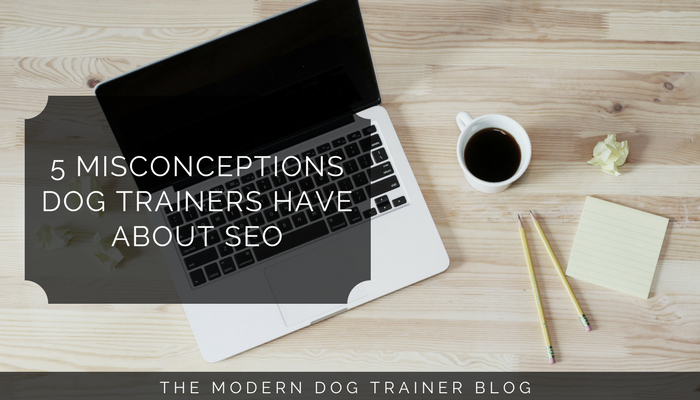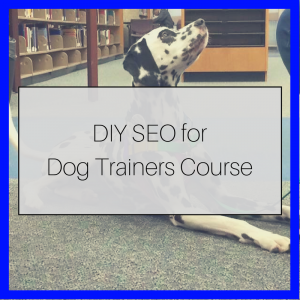
5 Misconceptions Dog Trainers Have About SEO
 Part of having a successful business means you need a website that works for you. Ideally, you want a website to be attracting clients to your business even when you’re sleeping. Many dog trainers are missing out on the benefits of SEO and what it could do for their businesses whether they know SEO exists or not. Thankfully, it’s not as scary as you might think and a lot of SEO can be done in “DIY” fashion on a $0 budget. Today, I’m going to dive into some of the myths I’ve seen other dog trainers believe over the years.
Part of having a successful business means you need a website that works for you. Ideally, you want a website to be attracting clients to your business even when you’re sleeping. Many dog trainers are missing out on the benefits of SEO and what it could do for their businesses whether they know SEO exists or not. Thankfully, it’s not as scary as you might think and a lot of SEO can be done in “DIY” fashion on a $0 budget. Today, I’m going to dive into some of the myths I’ve seen other dog trainers believe over the years.
1) You Don’t Know What It Stands For
The acronym is much easier to type and say so “SEO” is used infinitely more often than “Search Engine Optimization.” This means that the term scares people away and is
2) You Think They Can Pay Someone Else To Do It
Unfortunately, as small business owners, we’re constantly bombarded by ads and promotions on how someone can magically snap their fingers and get our website to rank on the first page of Google. All for only $300 per month! Just think of all the new clients you could bring in with that kind of exposure. Too good to be true? Yep…
Unless you’re paying Google directly via AdWords, you’re not going to get your site to rank by paying anyone. There are loads of scams out there preying on unsuspecting business owners that are promised mysterious rankings for a small monthly fee. To get on the first page of Google results, you have to earn it by:
- Providing helpful, relevant information to the people that are searching
- Optimizing the technical aspects of your website to help it function better for visitors.
3) You Don’t Understand The Point Of It
SEO has remained this mysterious, unclear marketing term that many new business owners shy away from. In reality, it’s easy and important for all businesses to understand. SEO, or Search Engine Optimization, is
I agree – it can be overwhelming to learn about all the different ways you can improve your website, but you want to keep chipping away at it over time. Every little bit helps your website and your business get found online when people are looking for help. Best of all, when you have a small starting up
Don’t know what improvements to make? Check out my course: DIY SEO for Dog Trainers.
4) You Don’t Do The Right Research (And Make The Wrong Assumptions)
After spending hours in forums online discussing dog training with other professionals, it’s easy to forget how the average dog owner would search for common issues such as resource guarding or leash reactivity. When optimizing for search engines, you should think about the kind of people you want to attract to your website and understand the terms they’re likely to use to find help for their problems.
Here is a comparison of how the terminology might differ between a professional dog trainer and an average dog owner.
Terms Dog Trainers Might Use
- Resource guarding
- On-leash reactivity
- Dog manners group class
- Crate training
- Positive reinforcement based training
Terms Dog Owners Might Use
- Snapping and growling with toys
- Barking at other dogs on walks
- Dog obedience training
- Puppy potty training/
house breaking - Positive dog training
With this understanding, you want to make sure your website is written with the vocabulary that is familiar and natural to your target audience. They’re using the search engine to find YOU!
5) They Don’t Even Realize Their Website Is Hurting Them
Living in a smaller town means that many small businesses have not invested in websites that perform well and many don’t even have
With most people turning to mobile searches instead of to their neighbors to find help these days, you cannot afford to miss out on potential customers looking for trainers just like you in your area. A bad website could:
- Load so slowly that the visitor hits the back button before they even get to see your site.
- Be so complicated that the visitor just goes back to search for another business to help them.
- Make the location of the business so vague or unapparent that the visitor can’t tell what state, let alone what city, the business is in.
- Rank so poorly in search engines that you can’t find the business’s website even if you were to type in the exact name of the business.
“Nearly 60 percent of searches now from mobile devices.” – Search Engine Land
Outside of not being able to be found online or a super slow load time, your website could be hurting your reputation, too. An outdated or 90’s looking website could look unprofessional and could even lead people to believe that you’re out of business! A website is your virtual storefront. Take care to make it visually appealing and helpful
An SEO Course For Dog Trainers
 Feeling overwhelmed? Wish someone would walk you through the right steps to optimize your website? I’ve put all my tips and tricks into a 5 week, open enrollment, email course to walk you through:
Feeling overwhelmed? Wish someone would walk you through the right steps to optimize your website? I’ve put all my tips and tricks into a 5 week, open enrollment, email course to walk you through:
- an SEO Audit – learn about how your website is performing and what is missing so you know where you stand.
- technical SEO improvements – changes you can make yourself without hiring outside help.
- a content strategy – learn about what content your website’s pages need to include to attract the right customers.
- a blogging strategy – know what to write about to attract local dog owners to your site without wasting your time.




